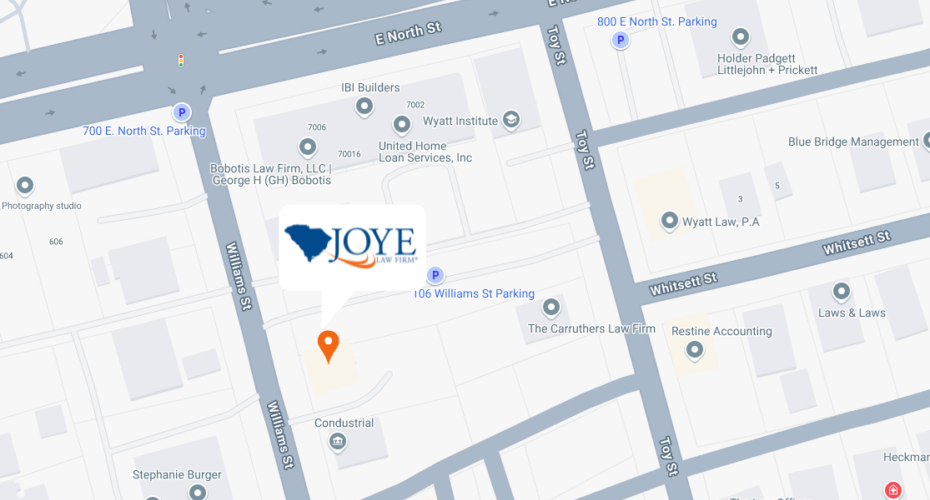
In South Carolina, the statute of limitations to file a personal injury claim is three years, the law allows a person that was injured to file a lawsuit seeking compensation for their injuries, financial losses, and pain and suffering from the liable party. The three years countdown starts the moment a person is injured. If the claim is against a governmental entity, the injured party typically has two years to act.
The deadline to bring a claim is known as the statute of limitations. A statute of limitations is applied to legal claims based on the belief that evidence and witnesses’ memories degrade over time, and a deadline promotes the timely resolution of claims.
What is more important to understand about South Carolina’s statute of limitations is that it means you should seek guidance from a personal injury lawyer about your legal rights as soon as possible after someone has harmed you. It takes months to investigate an accident, obtain records, deal with insurance companies, and prepare a personal injury lawsuit. In many instances, it takes much of the time allowed under the statute of limitations.
Get Free Legal Advice and Timely Action on Your Claim
At Joye Law Firm, we can answer your questions about a personal injury claim in a free, no-pressure legal consultation. If we see a way to move forward with a claim on your behalf, we will offer to handle it with a contingency arrangement. You will not owe us any legal fee unless we recover compensation for you. In other words, we only get paid if you get paid.
Promptly contacting an experienced Joye Law Firm personal injury attorney is the best way to protect your rights if someone in South Carolina has left you with serious injuries, hospital bills, and other losses. The attorneys at Joye Law Firm have been seeking just compensation for accident and injury victims since 1968. We serve clients across South Carolina and have offices in North Charleston, Myrtle Beach, Clinton, Columbia, and Summerville.
Don’t wait if you believe that you may have reason to pursue a personal injury claim in South Carolina. Contact us now for free legal advice.
Types of Injuries Covered by the S.C. Personal Injury Statute of Limitations
The law stating South Carolina’s statute of limitations on personal injury claims is found in SC Code § 15-3-530(5) (2012). The legal language says actions for recovering compensation shall start within three years if the claim is about “assault, battery, or any injury to the person or rights of another,” unless a different limit is stated in another statute.
This statute of limitations for personal injury lawsuits applies to cases involving another party’s negligence or criminal conduct that leads to accidents such as:
- Car accidents
- Truck accidents
- Motorcycle accidents
- Pedestrian accidents
- Dog bite injuries
- Slip and fall injuries
- Nursing home abuse
- Criminal assault, such as allowed by negligent security.
In a personal injury lawsuit, the injured party must establish that:
- The party at fault owed the plaintiff a duty of care
- The defendant, by negligence or intent, failed to meet their duty of care
- The defendant’s action or failure to act is the most closely related cause of the person’s injury
- The plaintiff suffered harm that can be made better through compensation
In a car accident claim, our attorneys would seek to show that the defendant failed to meet their responsibility to comply with traffic safety laws by speeding, driving while distracted, or taking some other unsafe action. We would seek to show that unsafe driving resulted in the car accident that caused the plaintiff’s injury such as a traumatic brain injury (TBI).
In addition to the head injury, a person injured in a car accident also would sustain harm through having significant medical expenses, loss of income, car repair bills, and pain and suffering. The lawsuit would demand an amount of compensation to cover our client’s losses and make our client financially whole.
What Are Exceptions to The Statute of Limitations in South Carolina?
Various state statutes establish exceptions to the three-year deadline for personal injury claims. They include:
- Medical malpractice. A separate statute allows patients injured by medical malpractice more time to file lawsuits if a medical error was only discovered long after it occurred and certain other conditions are met. An example would be the discovery of a surgery tool accidentally left in a patient’s body.
- Workplace injuries. Most individuals who are injured while on the job are covered by the rules of South Carolina’s workers’ compensation system. Injured workers must file a workers’ compensation claim within two years of the date of their injury or the discovery that a work injury has occurred or the diagnosis of an occupational illness.
- Children’s injuries. Children generally have until they turn 19 years old to sue for harm suffered in childhood accidents. In claims based on sexual abuse or incest, the plaintiff has six years from when they turn 21 years old or three years from when they realize their injury and the causal relationship between the injury and the sexual abuse or incest, whichever occurs later.
- Governmental Agencies: If the person responsible for your injury was an agent or representative of the government, or if you were injured while on government property, you generally only have two years to file your claim.
Why the Statute of Limitations on Personal Injury Claims Matters
Two or three years to file a lawsuit may seem like plenty of time, but it goes by faster than you might think. A disputed claim typically has complicating factors that must be addressed.
A disputed claim requires us to investigate and compile evidence that supports what you will assert in the lawsuit – evidence that what the defendant did or failed to do caused your injury. We must be ready to rebut any claims the defense makes.
To accurately calculate what compensation you are owed, we must wait until you have completed all medical treatment, including any rehabilitation you require. For a serious injury, this may take a year or longer.
Before filing a lawsuit, we typically conduct an investigation of your injury and file your claim with the defendant’s insurance company. The insurer will pay any settlement or jury award in most cases. The insurer must be allowed time to review your claim and conduct their own investigation. They may deny the claim, or offer a settlement for less money than we demanded. This may lead to settlement negotiations, which some insurers use as a way to try to run out the clock on the filing deadline.
It is always better to start work on a personal injury claim as soon as possible so there is no undue pressure. Our attorneys keep track of how the statute of limitations applies to your case and will make sure your case is filed in a timely fashion.
Statutes of Limitations for All 50 States (and the District of Columbia)
| State | Personal Injury | Property Damage |
| Alabama | 2 Years Ala. Stat. § 6-2-38 | 2 Years Ala. Stat. § 6-2-38 (Except actions based on conversion and actions involving wanton conduct or an intentional tort to real or personal property, which is 6 years. Ala. Stat. § 6-2-34(3)); Ex parte Capstone Bldg. Corp., 96 So.3d 77 (Ala. 2012). |
| Alaska | 2 Years Alaska Stat. § 09.10.070(a) | 2 Years Alaska Stat. § 09.10.050, 070(a) |
| Arizona | 2 Years A.R.S. § 12-542 | 2 Years A.R.S. § 12-542 |
| Arkansas | 3 Years A.C.A. § 16-116-103 Medical Malpractice: 2 Years A.C.A. § 16-114-203(a) | 3 Years A.C.A. § 16-116-103 |
| California | 2 Years Cal. Civ. Proc. Code § 335.1 | 3 Years Cal. Civ. Proc. Code § 338(c) Contractors/Architects: 3 years from substantial completion. City School Dist. of Newburgh v. Stubbins, 85 N.Y.2d 535 (1995). |
| Colorado | 2 Years C.R.S. § 13-80-102 3 Years If Motor Vehicle Involved C.R.S. § 13-80-101(n)(I) City & Cty. of Denver v. Gonzales, 17 P.3d 137 (Colo. 2001); Jones v. Cox, 828 P.2d 218 (Colo. 1992). | 2 Years C.R.S. § 13-80-102 3 Years If Motor Vehicle Involved C.R.S. § 13-80-101(n)(I) City & Cty. of Denver v. Gonzales, 17 P.3d 137 (Colo. 2001); Jones v. Cox, 828 P.2d 218 (Colo. 1992). |
| Connecticut | 2 Years C.G.S.A. § 52-584 | 2 Years C.G.S.A. § 52-584 |
| Delaware | 2 Years (3 Years if not discoverable in 2 Years) 10 Del. C. § 8119 | 2 Years (3 Years if not discoverable in 2 Years) 10 Del. C. § 8107 |
| District of Columbia | 3 Years Wrongful Death: 1 Year D.C. Code § 12-301 | 3 Years D.C. Code § 12-301 |
| Florida | 4 Years F.S.A. § 95.11(3)(a),(o) Wrongful Death: 2 Years F.S.A. § 95.11(4)(d) Medical Malpractice: 2 Years F.S.A. § 95.11(4)(b) | 4 Years F.S.A. § 95.11(3)(a),(o) |
| Georgia | 2 Years O.C.G.A. § 9-3-33 | 4 Years O.C.G.A. §§ 9-3-30 (real property) and 9-3-31 (personal property). NOTE: SOL for damage to home (assuming original owner) begins to run from date of substantial completion even though this means SOL might run before accident occurs. Corp. of Mercer Univ. v. Nat. Gypsum Co., 368 S.E.2d 732 (Ga. 1988) |
| Hawaii | 2 Years Haw. Rev. Stat. § 657-7 | 2 Years Haw. Rev. Stat. § 657-7 |
| Idaho | 2 Years Idaho Code § 5-219(4) | 3 Years Idaho Code § 5-218(2),(3) |
| Illinois | 2 Years 735 I.L.C.S. § 5/13-202 Construction: 4 Year SOL may apply if “design, planning, supervision, observation, management of construction, or construction of an improvement to real property” is involved. 735 I.L.C.S. § 5/13-214(a); Fed. Ins. Co. v. Konstant Architecture Planning, Inc., 902 N.E.2d 1213 (Ill. App. 2009). Medical Malpractice: Statutes vary as defined in 735 I.L.C.S. § 5/13-212. | 5 Years 735 I.L.C.S. § 5/13-205 |
| Indiana | 2 Years I.C. § 34-11-2-4 | 2 Years I.C. § 34-11-2-4 |
| Iowa | 2 Years I.C.A. § 614.1(2) | 5 Years I.C.A. § 614.1(4) |
| Kansas | 2 Years K.S.A. § 60-513 | 2 Years K.S.A. § 60-513 |
| Kentucky | 1 Year K.R.S. § 413.140(1)(a) 2 Years If Motor Vehicle Involved K.R.S. § 304.39-230(6) | 2 Years K.R.S. § 413.125 |
| Louisiana | 1 Year L.S.A.-C.C. Art. § 3492 Generally, a one-year prescriptive period for tort claims. However, some torts have a longer time period. | 1 Year L.S.A.-C.C. Art. § 3492 In Louisiana, a statute of limitations is known as a liberative prescription. Liberative prescription is defined as a mode of barring actions as a result of inaction for a period of time. |
| Maine | 6 Years (Unless Exception Applies). 14 M.R.S.A. § 752 Wrongful Death: 2 Years 18-A M.R.S.A. § 2-804(b) Medical Malpractice: 3 Years 24 M.R.S.A. § 2902 | 6 Years 14 M.R.S.A. § 752 |
| Maryland | 3 Years Md. Cts. & Jud. Proc. Code § 5-101 Medical Malpractice: Earlier of 5 years after injury date or 3 years after injury was discovered. | 3 Years Md. Cts. & Jud. Proc. Code § 5-101 |
| Massachusetts | 3 Years Mass. Ann. Laws Ch. 260 §§ 2A and 4 | 3 Years Mass. Ann. Laws Ch. 260 §§ 2A and 4; Mass. Ann. Laws Ch. 106 §§ 2-318 |
| Michigan | 3 Years M.C.L.A. § 600.5805(10) If insured auto involved, action against no-fault carrier must be filed in 1 year. M.C.L.A. § 500.3145. 1 Year after accident to make first-party PIP claim. M.C.L.A. § 500.3145 Medical Malpractice: The later of 2 years after alleged act or 6 months after injury discovered M.C.L.A. §§ 600.5805(6), 600.5838. | 3 Years M.C.L.A. § 600.5805(10) If insured auto involved, action against no-fault carrier must be filed in one (1) year. M.C.L.A. § 500.3145. |
| Minnesota | Intentional Acts: 2 Years M.S.A. § 541.07 Wrongful Death: 3 Years M.S.A. § 573.02 Negligence Claims: 6 Years M.S.A. § 541.05 subd. 1(5) Medical Malpractice: 4 Yrs. M.S.A. § 541.076(b) Legal Malpractice: 6 Yrs. M.S.A. § 541.05 | 6 Years M.S.A. § 541.05 |
| Mississippi | 3 Years M.C.A. § 15-1-49 Medical Malpractice: 2 Years M.C.A. § 15-1-36 | 3 Years M.C.A. § 15-1-49 |
| Missouri | 5 Years Mo. Rev. Stat. § 516.120(4) Medical Malpractice: 2 Years Mo. Rev. Stat. § 516.105 Wrongful Death: 3 Years Mo. Rev. Stat. § 537.100 | 5 Years Mo. Rev. Stat. § 516.120(4) |
| Montana | 3 Years Mont. Stat. § 27-2204(1),(2) | 2 Years Mont. Stat. § 27-2-207 (If property damage caused by tort, 3-year SOL may apply under § 27-2204. Ritland v. Rowe, 861 P.2d 175 (Mont. 1993)). |
| Nebraska | 4 Years Neb. Rev. Stat. § 25-207 Wrongful Death: 2 Years Neb. Rev. Stat. §§ 30-809 and 30-810 Medical Malpractice: 2 Years from injury date or 1 Year from date injury was discovered. Neb. Rev. Stat. § 25-222 | 4 Years Neb. Rev. Stat. § 25-207 |
| Nevada | 2 Years N.R.S. § 11.190 Action Against Health Care Provider: 3 Years from injury date or 1 Year from date of discovery. N.R.S. § 41A.097(2) | 3 Years N.R.S. § 11.190 |
| New Hampshire | 3 Years N.H. Rev. Stat. Ann. § 508:4(I) | 3 Years N.H. Rev. Stat. Ann. § 508:4(I) |
| New Jersey | 2 Years N.J.S.A. § 2A:14-2 | 6 Years N.J.S.A. §§ 2A:14-1 |
| New Mexico | 3 Years N.M.S.A. § 37-1-8 | 4 Years N.M.S.A. § 37-1-4 |
| New York | 3 Years N.Y. C.P.L.R. § 214, et seq. Wrongful Death: 2 Years N.Y. Est. Powers & Trusts Law § 5-4.1 Medical Malpractice: 2 Years and 6 Months (N.Y. C.P.L.R. § 214-a) | 3 Years N.Y. C.P.L.R. § 214, et seq. |
| New Carolina | 3 Years N.C.G.S.A. § 1-52(1)-(5); Nelson v. Patrick, 293 S.E.2d 829 (N.C. 1982). Wrongful Death: 2 Years N.C.G.S.A. § 1-53(4) | 3 Years N.C.G.S.A. § 1-52(1)-(5) |
| New Dakota | 6 Years N.D.C.C. § 28-01-16(5) Medical Malpractice: 2 Years, possibly extend to 6 Years, based on date of discovery. N.D.C.C. § 28-01-18(3). Wrongful Death: 2 Years N.D.C.C. § 28-01-18(4) | 6 Years N.D.C.C. § 28-01-16 |
| Ohio | 2 Years O.R.C.A. § 2305.10(A) Medical Malpractice: 1 Year O.R.C.A. § 2305.113(A) | 2 Years O.R.C.A. § 2305.10(A) |
| Oklahoma | 2 Years Okla. Stat. Ann. Tit. 12, § 95 | 2 Years Okla. Stat. Ann. Tit. 12, § 95 |
| Oregon | 2 Years O.R.S. § 12.110(1) Wrongful Death: 3 Years O.R.S. § 30.020(1) | 6 years for damage to personal property. O.R.S. § 12.080(3) 2 years for negligent damage to real property. O.R.S. § 12.110(1) (Except actions based on conversion and actions involving trespass or waste, which is 6 years. O.R.S. § 12.080(3), (4); Goodwin v. Kingsmen Plastering, Inc., 359 Or. 694, 696, 375 P.3d 463, 465 (2016)). |
| Pennsylvania | 2 Years 42 P.S. § 5524 | 2 Years 42 P.S. § 5524 |
| Rhode Island | 3 Years R.I.G.L. § 9-1-14 (b) | 10 Years Romano v. Westinghouse Elec. Co., 336 A.2d 555 (R.I. 1975). |
| South Carolina | 3 Years S.C. Code Ann. §§ 15-3530, 15-3-535, 15-3-545 | 3 Years S.C. Code Ann. §§ 15-3530, 15-3-535 |
| South Dakota | 3 Years S.D.C.L. § 15-2-14(3) Medical Malpractice: 2 Years S.D.C.L. § 15-2-14.1 | 6 Years S.D.C.L. § 15-2-13(4) |
| Tennessee | 1 Year T.C.A. § 28-3-104 | 3 Years T.C.A. § 28-3-105 |
| Texas | 2 Years Tex. Civ. Prac. & Rem. Code Ann. § 16.003 | 2 Years Tex. Civ. Prac. & Rem. Code Ann. § 16.003 |
| Utah | 4 Years U.C.A. § 78B-2-307(3) Wrongful Death: 2 Years Medical Malpractice: 2 Years U.C.A. § 78B-2-304(2) and U.C.A. § 78(B)-3-404 | 3 Years U.C.A. § 78B-2-305(1) Improvements to Real Property: 2 Years U.C.A. § 76B-2-225 |
| Vermont | 3 Years Vt. Stat. Ann. Tit. 12, § 512(4) Wrongful Death: 2 Years Vt. Stat. Ann. Tit. 14, § 1492 Medical Malpractice: Later of 3 years from incident or 2 years from discovery. Vt. Stat. Ann. Tit. 12, § 521. | 3 Years Vt. Stat. Ann. Tit. 12, § 512(5) |
| Virginia | 2 Years Va. St. § 8.01-243(A) | 5 Years Va. St. § 8.01-243(B) |
| Washington | Intentional Acts: 2 Years R.C.W.A. § 4.16.100 Negligence Claims: 3 Years R.C.W.A. § 4.16.080 Medical Malpractice: Later of 3 years from date of act or 1 year from discovery of injury. R.C.W.A. § 4.16.350 | Intentional Acts: 2 Years R.C.W.A. § 4.16.100 Negligence Claim: 3 Years R.C.W.A. § 4.16.080 |
| West Virginia | 2 Years W. Va. Code § 55-2-12 | 2 Years W. Va. Code § 55-2-12 |
| Wisconsin | Non-Auto Bodily Injury: 3 Years (auto and nonauto) Wis. Stat. § 893.54(1m) Assault/Battery/Libel/Slan der/Intentional Act: 3 Years, Wis. Stat. § 893.54. Death Arising from Accident Involving Motor Vehicle occurring on or after 2/6/16: 2 Years from date of accident – not death. Wis. Stat. § 893.54(2m); Christ v. Exxon Mobil Corp., 866 N.W.2d 602 (Wis. 2015). Death Arising from Accident Involving Motor Vehicle occurring prior to 2/6/16: 3 Years from date of accident. | 6 Years (Non-Auto) Wis. Stat. § 893.52(1) 3 Years (Auto) Wis. Stat. § 893.52(2). Action for property damage (real or personal), which accrues prior to 2/6/16, must be brought within six (6) years after the cause of action accrues. Wis. Stat. § 893.52(1). For actions after 2/6/16 if property damages are caused by a motor vehicle, action must be brought within three (3) years. Wis. Stat. § 893.52(2) |
| Wyoming | Personal Injury: 4 Years Wyo. Stat. § 1-3105(a)(iv)(C) Wrongful Death: 2 Years Wyo. Stat. § 1-38-102(d) Medical Malpractice: 2 Years, unless discovery in 2nd year, then extended by 6 months. Wyo. Stat. §§ 1-3-107(a)(I) and (a)(iv). | 4 Years Wyo. Stat. § 1-3105(a)(iv)(C) |
These materials by Joye Law Firm may become outdated or superseded as time goes by (last updated: 9/2024). If you should have questions regarding the current applicability of any topics contained in this publication or any of the publications distributed by Joye Law Firm, please call 888-324-3100 or contact us online. This information should not be construed as legal advice concerning any factual situation and representation of individuals by Joye Law Firm on specific facts disclosed within the attorney\client relationship. These materials should not used in lieu thereof in anyway.
Schedule a Free Case Review with Our South Carolina Personal Injury Lawyers
Contact Joye Law Firm as soon as you are able if you have been seriously injured in an accident that was someone else’s fault. We do not charge for an initial consultation and handle personal injury claims on a contingency fee basis. We do not charge legal fees unless we recover compensation for you.
Our personal injury attorneys have been helping South Carolina accident victims like you for more than 50 years. Please call us at 888-324-3100 or contact us online today to schedule your free case review.







































